In today’s fast-paced business world, effective collaboration and seamless communication are vital for organisations to thrive. A crucial aspect of facilitating successful meetings lies in the design and layout of office meeting rooms. Traditionally, most offices have adopted a generic layout for their meeting spaces.
However, in recent times, alternative layouts have emerged, enhancing collaboration for hybrid setups that contain a mix of in-room and remote audiences. In this blog, we will delve into the best types of office meeting room layouts and collaboration spaces, exploring how they have evolved from conventional designs to cater to diverse organisational needs.
Meeting Room Goals – What are You Using Them For
Historically, the standard office meeting room layout often featured a rectangular table surrounded by chairs, with a designated leader’s seat at the head of the table. This layout aimed to establish a hierarchical structure and promote formal discussion. However, as workplace dynamics have evolved, organisations have recognised the importance of fostering a more inclusive and interactive environment during meetings.
Depending on the type of collaboration you seek, there are several options to choose from.
Instructional: An instructional collaborative space is equipped with large monitors, projection screens, displays and audio equipment. It serves best when you need to teach your team something new with little discussion. In this setting, a single person or a small team educates an audience. Engaging the audience requires high-quality signal management and crisp visual displays.
Goal-oriented: When multiple cross-functional teams need to work collaboratively on a specific project, it is essential to have a room that allows numerous individuals from different locations or those in the same room to use their own devices to connect seamlessly. Equipment that can effectively handle HDMI signals from various sources to multiple destinations is crucial for this kind of setup.
Ideation: Visionary thinking, novel innovative ideas, finding new ways to tackle existing problems, and resilience are all drivers of exponential business growth. To foster the right conditions and provoke brilliant ideas, your teams need a spacious area where they can work together while also facilitating quiet conversations or one-on-one collaborations. Having the right atmosphere guided by the right layout and lighting is paramount here.
Connecting: In the digital age, personal and professional relationships rely heavily on virtual connections. A well-designed space can be utilised for networking events, team-building activities, and collaborative projects. Ensuring the comfort and seamless functionality of these environments not only boosts productivity and creativity but also enhances the overall employee experience, leading to a more motivated and cohesive workforce.
Also Read: Top 5 Tips for Boardroom Design and Integration
Meeting Room Layouts – What Are Your Options
Open/Closed Layout
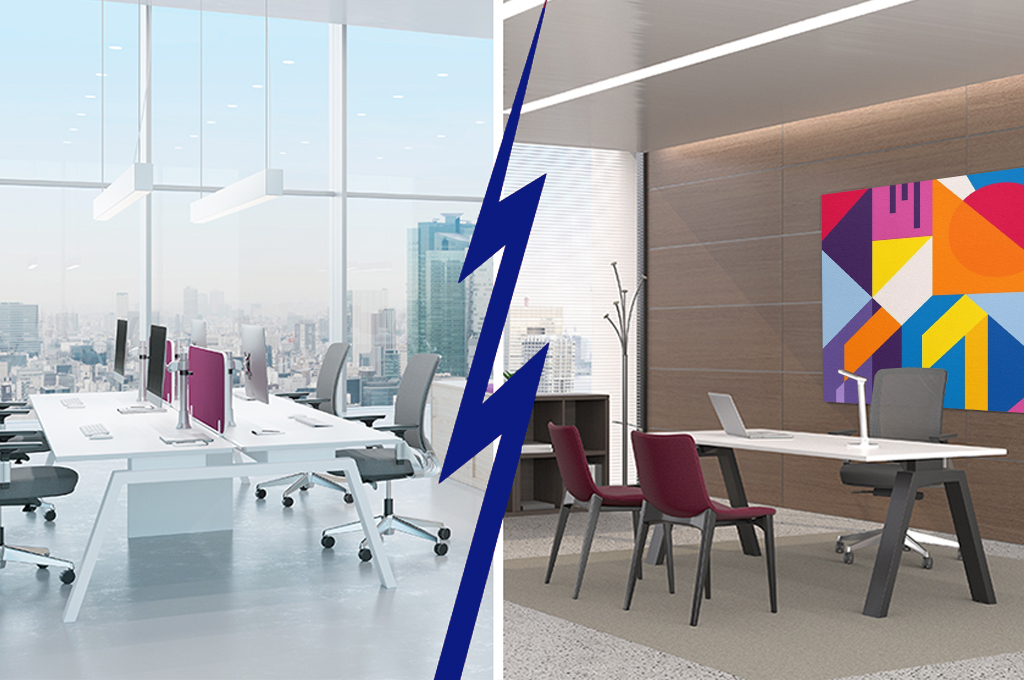
An open layout promotes a collaborative atmosphere by eliminating physical barriers. It typically consists of a large table or multiple smaller tables with chairs placed around them. This layout encourages equal participation and free-flowing discussions. On the other hand, a closed layout incorporates partitions or walls to create individualised spaces within a meeting room. They provide privacy and confidentiality, making them suitable for discussions that require a high level of discretion.
Ideal for: Open meeting room layouts can be utilised for brainstorming sessions, creative discussions, team-building activities, and collaborative problem-solving. Closed meeting room layouts are best suited for confidential discussions, sensitive matters, negotiations, and formal presentations.
Video Conferencing (VC) Room Layout

In today’s interconnected world, remote collaboration has become increasingly common. A VC room layout is specifically designed to facilitate seamless video conferencing sessions. It incorporates audiovisual equipment, such as large screens, cameras, and quality sound systems, ensuring clear communication and engagement between on-site and remote participants. This enables teams to collaborate effectively, regardless of geographical distances, fostering greater productivity and strengthening partnerships across borders.
Ideal for: VC room layouts are particularly beneficial for organisations with remote teams, satellite offices, or international partners. They enable real-time communication and collaboration, fostering teamwork and reducing the need for physical travel, thereby saving time and resources. Additionally, they facilitate meetings with clients, customers, or external partners, making them a valuable asset for modern businesses with a global presence.
U-shaped or V-shaped Seating
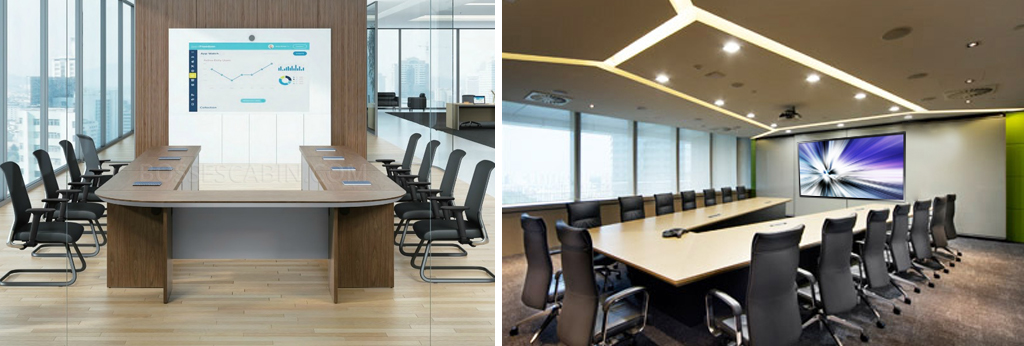
U-shaped or V-shaped seating arrangements foster a sense of inclusivity and equality among participants. These layouts typically feature a table in the shape of a “U” or “V,” with chairs placed around the perimeter. This setup encourages face-to-face interaction, allowing everyone to see and engage with each other. U-shaped or V-shaped seating is particularly effective for discussions that require active participation, collaborative decision-making, and presentations to smaller groups.
Ideal for: Where the U-shaped layout is best utilised for small group discussions, training sessions, workshops, and team-building activities, the V-shaped layout is best suited for presentations, lectures, and panel discussions. The U-shaped arrangement creates a more intimate and collaborative atmosphere while the V-shaped configuration is designed to focus the audience’s attention on a central point, such as a speaker or a presentation screen.
Wedge-shaped Seating
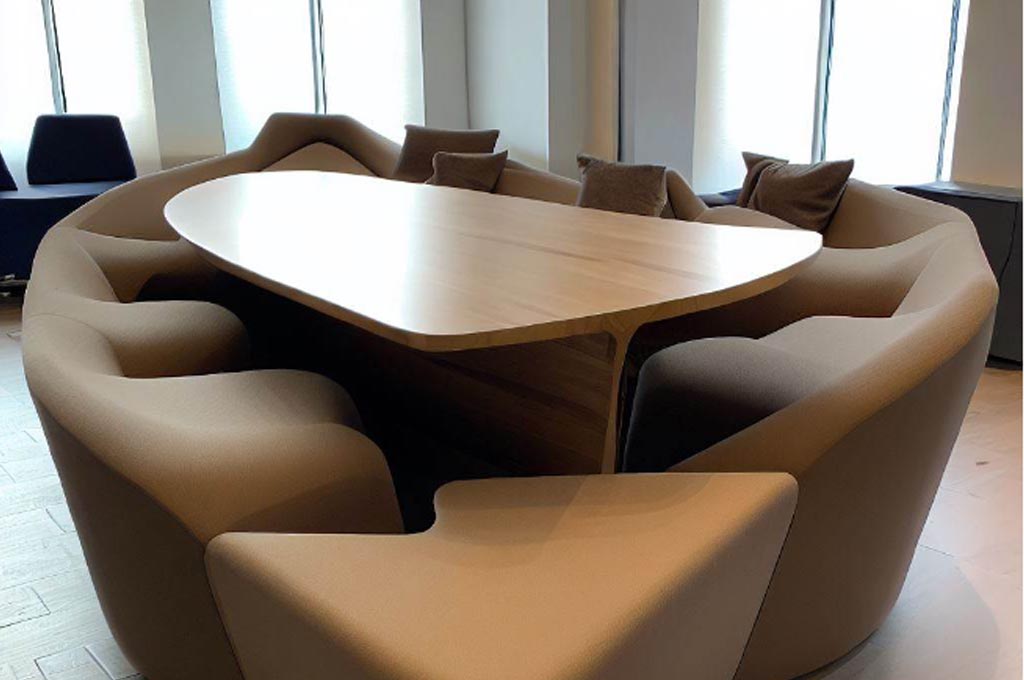
Wedge-shaped seating layouts offer a modern twist to traditional meeting room setups. They feature a triangular table with chairs positioned around it. This layout enhances visibility and encourages a more intimate discussion among participants. The wedge-shaped seating layout resembles a fan or wedge, with the wider end facing the audience and the narrower end where speakers or panellists sit.
Ideal for: The wedge-shaped seating layout is best suited for panel discussions and interactive presentations, promoting clear visibility among speakers and encouraging audience engagement. The open end facilitates Q&A sessions and keeps the audience’s focus on the central point, making it suitable for events that emphasise discussions and interactions between speakers and the audience.
Also See: Solutions on Meeting & Presentation
Hollow Square Seating
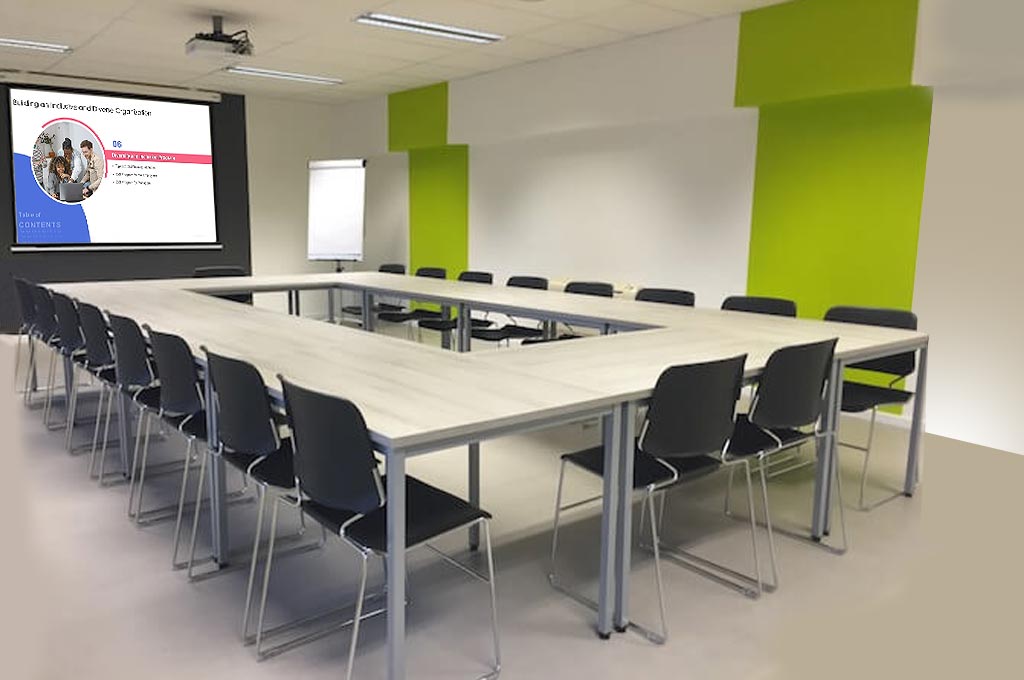
The hollow square seating layout consists of tables arranged in a square with an open space in the middle. Participants sit on the outer sides of the tables, facing inward, creating an enclosed space. This setup fosters open communication and allows participants to see and engage with each other easily. It is used for small group discussions, meetings, and workshops where interaction and collaboration among attendees are essential.
Ideal for: The hollow square layout encourages a sense of equality among participants and is conducive to brainstorming sessions, decision-making processes, and team-building activities. It is also perfect for breakout sessions involving smaller groups working on similar problems or tasks. The workshop conductor or moderator in the central area can move freely between tables, offering guidance and monitoring the progress of each team.
Auditorium Style Seating
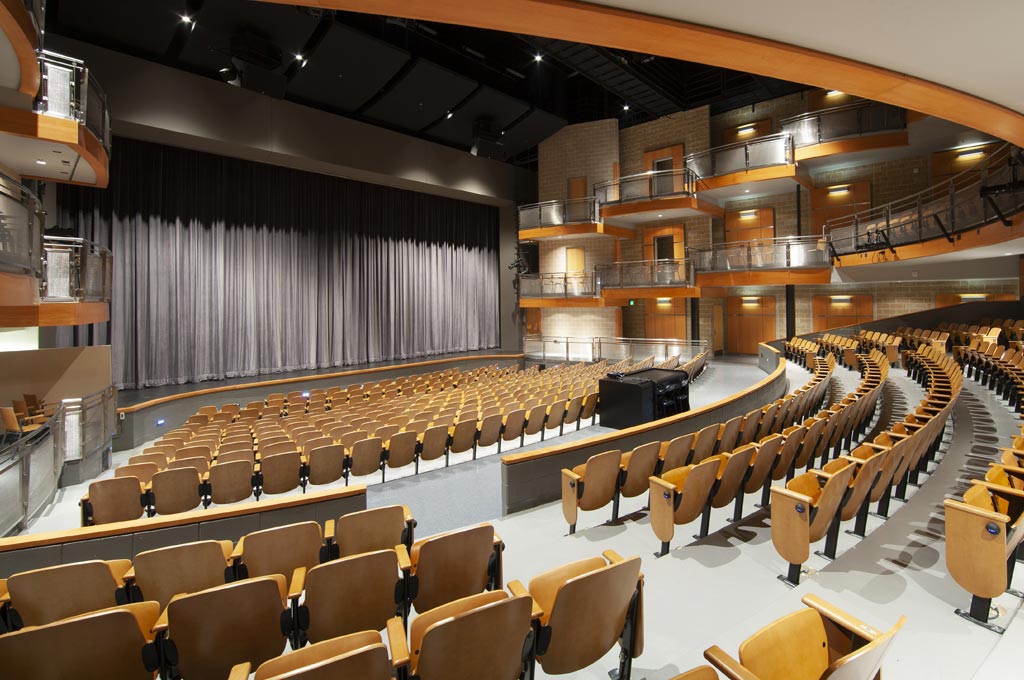
Auditorium seating in office spaces refers to a layout where rows of fixed seats face a stage or presentation area. The tiered seating design allows for optimal utilisation of space, accommodating a larger audience within a limited area. It promotes a sense of unity and cohesion among employees, as they gather to hear critical updates, share insights, and engage in company-wide discussions.
Ideal for: It’s best suited for large-scale presentations, town hall meetings, training sessions, and all-hands gatherings. This seating arrangement ensures a clear line of sight for attendees, making it suitable for events with a significant number of participants. It fosters a formal and focused atmosphere, making it perfect for important company announcements, product launches, and keynote speeches
Banquet/Cabaret/Reception Style Seating
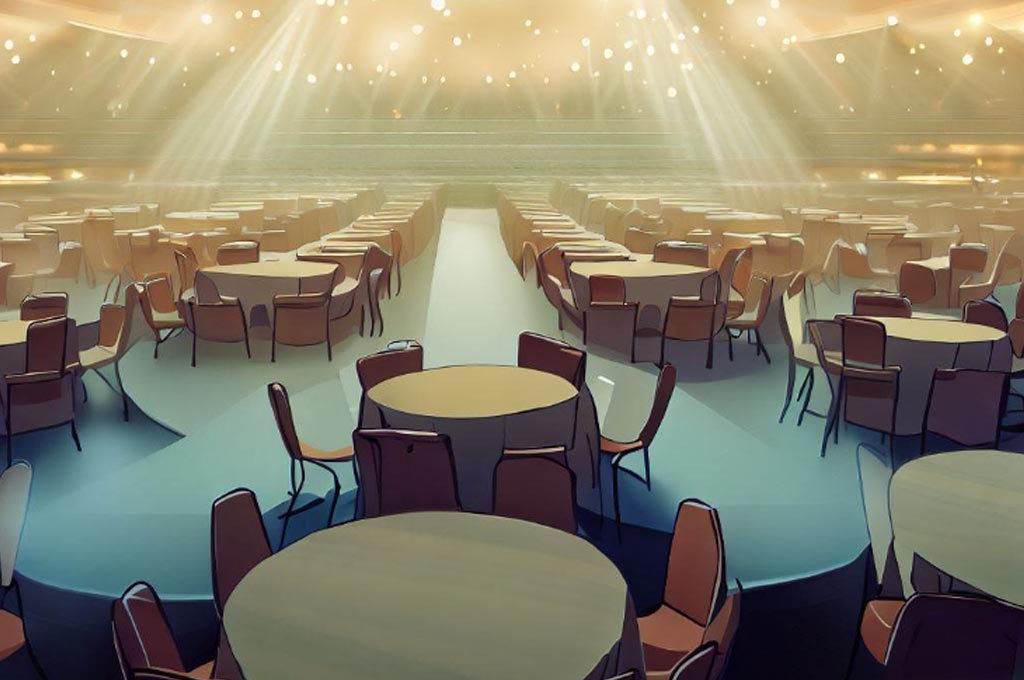
All three seating layouts involve circular tables surrounded by people with some minor differences between them. In a banquet-style seating arrangement, people are seated along the entire circumference of the circular tables facing each other and enabling maximum utilisation of space as well as enhanced networking within small groups. In contrast, the cabaret-style seating arrangement has people seated in only a semi-circular portion of the table, leaving space in front for the speaker to be visible to everyone. With reception-style seating, standing cocktail tables are thrown into the mix along with group tables providing an excellent setup for networking and mingling.
Ideal for: Banquet-style seating is ideal for team-building activities, sit-down dinners, and award nights. Cabaret-style seating is best suited for presentations combined with meals whereas reception-style seating is highly conducive to breakout chats and is recommended for dynamic pieces of training with cooperative and team-building activities.
Boardroom Style Seating

Boardroom-style seating is a formal arrangement in which a long rectangular table is surrounded by chairs on all sides. This layout is commonly used for executive meetings, board meetings, and high-level discussions. It promotes a sense of authority and professionalism, emphasising the central role of the meeting’s leader or presenter. It facilitates effective interaction among participants, fosters a collaborative environment, and allows everyone to have a clear view of each other, promoting engagement and ensuring that important matters are addressed with efficiency and efficacy.
Ideal for: Boardroom-style seating encourages focused communication and decision-making, making it ideal for gatherings that require in-depth discussions, problem-solving, and strategic planning.
Classroom Style Seating
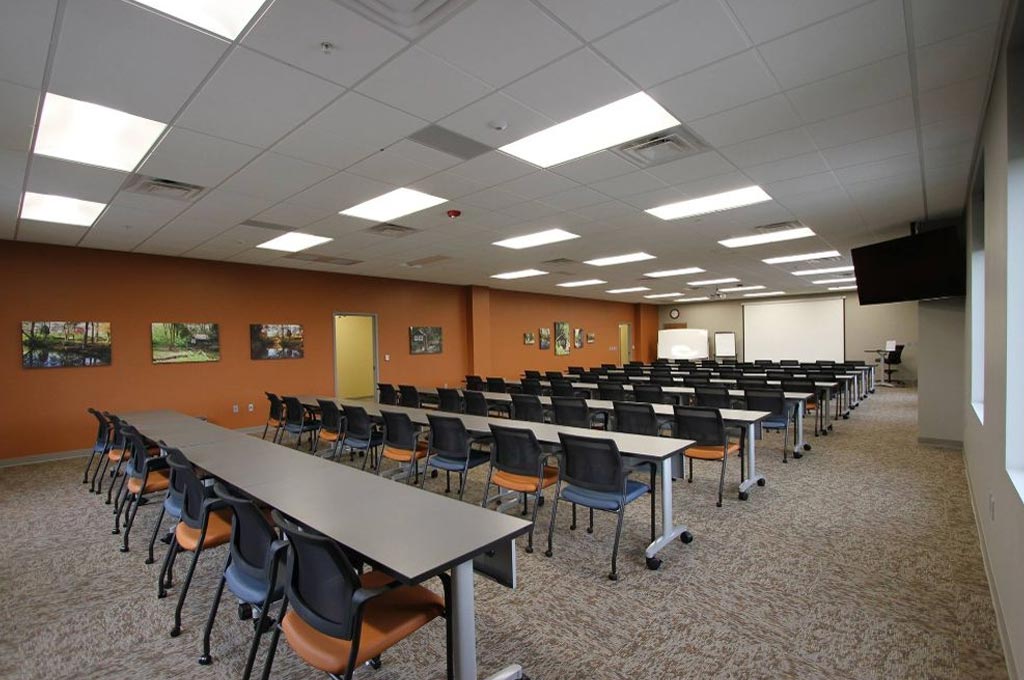
Classroom-style seating is a traditional setup where rows of desks or tables face the front of the room, typically with chairs aligned behind them. Classroom-style seating promotes a structured learning environment, enabling the instructor to engage with the audience effectively. It also encourages note-taking and active participation. However, for group discussions or collaborative activities, this layout may limit face-to-face interaction. Despite this, classroom-style seating remains a widely-used configuration for knowledge-sharing and educational purposes.
Ideal for: This layout is commonly used in educational settings, training sessions, workshops, and seminars. It is ideal for presentations, lectures, and instructor-led activities, as it allows participants to have a clear view of the presenter and any visual aids.
Fishbowl Style Seating
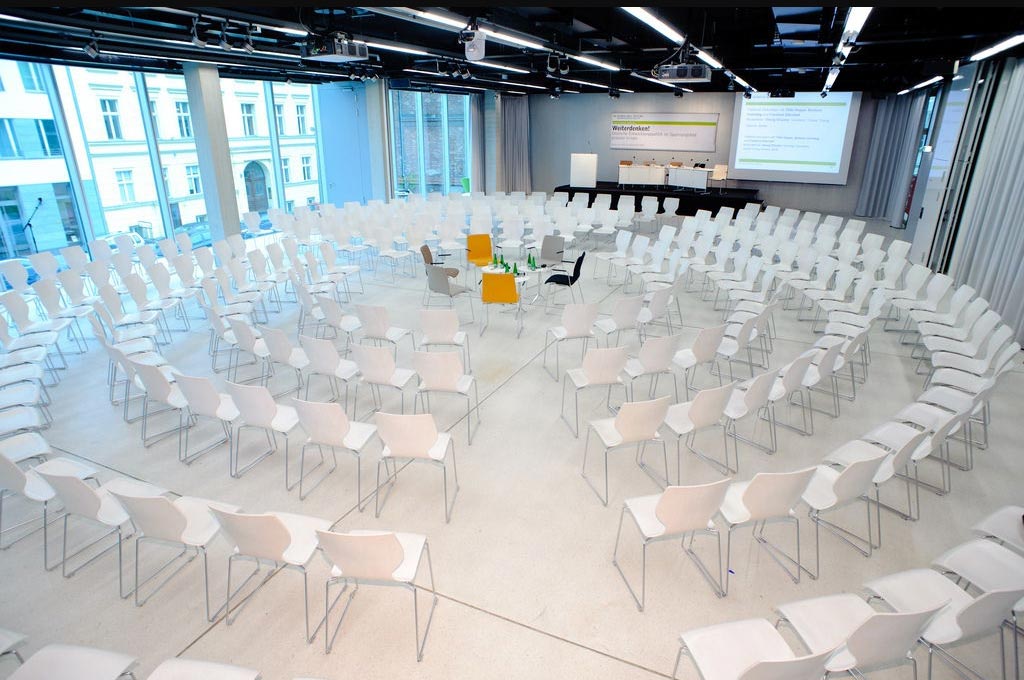
Fishbowl-style seating is an interactive seating arrangement where chairs are arranged in two concentric circles. The inner circle consists of participants who actively engage in the discussion, while the outer circle observes the conversation. Participants from the outer circle can rotate into the inner circle to contribute their thoughts, creating a dynamic and inclusive discussion environment.
Ideal for: This layout is ideal for group discussions, brainstorming sessions, and workshops where open dialogue and different perspectives are valued. It encourages active participation, facilitates idea-sharing, and promotes a deeper level of engagement among participants. Fishbowl-style seating is particularly useful for topics that require diverse viewpoints and collaborative problem-solving, making it a powerful tool for fostering communication and teamwork.
Also Read: Here’s How you can Optimise your Boardroom Design
Meeting Room Layouts – Important Considerations
Organisations should regularly evaluate their meeting room layouts to ensure they align with their evolving needs and objectives. Here are some key factors to consider when contemplating new layouts:
Evolving Organisational Culture: As organisations embrace a more collaborative and inclusive culture, it becomes imperative to reflect these values in meeting room layouts. If your company is transitioning towards a more open and transparent work environment, adopting an open layout with flexible seating arrangements can support this cultural shift.
Changing Meeting Dynamics: Analyse the types of meetings conducted within your organisation. Are they primarily formal discussions, brainstorming sessions, or collaborative workshops? Understanding the nature of your meetings and the desired outcomes can guide the selection of appropriate layouts. For example, if your teams frequently engage in collaborative problem-solving, a roundtable or open layout can encourage active participation and idea generation.
Technological Advancements: Technological advancements have revolutionised the way we collaborate and conduct meetings. Video conferencing, remote collaboration tools, and interactive displays have become integral to modern workplaces. If your organisation heavily relies on virtual meetings, a dedicated video conferencing room layout may be worth considering to enhance the remote collaboration experience.
Space Utilisation and Flexibility: Evaluate the utilisation of your existing meeting rooms. Are they frequently occupied, or do they often remain unused? Assessing the utilisation patterns can help identify opportunities for optimising space and improving efficiency. Additionally, consider the need for flexibility. Modular furniture and adaptable layouts can accommodate varying meeting sizes and configurations, allowing for versatile usage.
Employee Feedback: Involve employees in the decision-making process. Seek their input and insights regarding the existing meeting room layouts and any challenges they face. This feedback can provide valuable perspectives and highlight specific requirements or preferences that should be considered when implementing new layouts.
By regularly reviewing and reassessing meeting room layouts, organisations can adapt to changing needs, enhance collaboration, and promote productivity.
Also Read: Leveraging Conference Room AV Solutions for Efficient Meetings
Meeting Room Layouts – Why Specifics Matter
Adopting application-specific office meeting room layouts has numerous benefits. Firstly, these layouts create an environment that aligns with the purpose of the meeting, allowing participants to feel comfortable and engaged. Secondly, they promote equal participation, collaboration, and information sharing, breaking down hierarchical barriers. Thirdly, by considering the specific needs of each meeting, these layouts optimise the effective use of time and resources.
Furthermore, application-specific layouts help boost creativity, innovation, and productivity by creating an environment conducive to free-flowing discussions, active participation, and diverse perspectives. They also contribute to employee satisfaction and morale, as individuals feel valued and included in the decision-making process.
The days of one-size-fits-all office meeting room layouts are gradually fading away. Today, organisations recognise the importance of tailoring meeting spaces to cater to specific applications and enhance collaboration. By adopting open/closed layouts, video conferencing setups, U-shaped or V-shaped seating arrangements, and wedge-shaped seating, businesses can create environments that facilitate effective communication, foster innovation, and promote productivity.
As you design your office meeting rooms, consider the nature of your meetings and the desired outcomes. With thoughtful planning and application-specific layouts, you can transform your meeting spaces into dynamic hubs that inspire collaboration and unlock the full potential of your teams. Embrace the power of diverse layouts and watch as your meetings evolve into productive and engaging sessions that propel your organisation forward.
Join the numerous corporations that have trusted Actis Technologies for meeting room technology needs and take the next step in transforming your meeting rooms into collaborative and productive spaces.
Get in touch with Actis Technologies at 022-30808000


